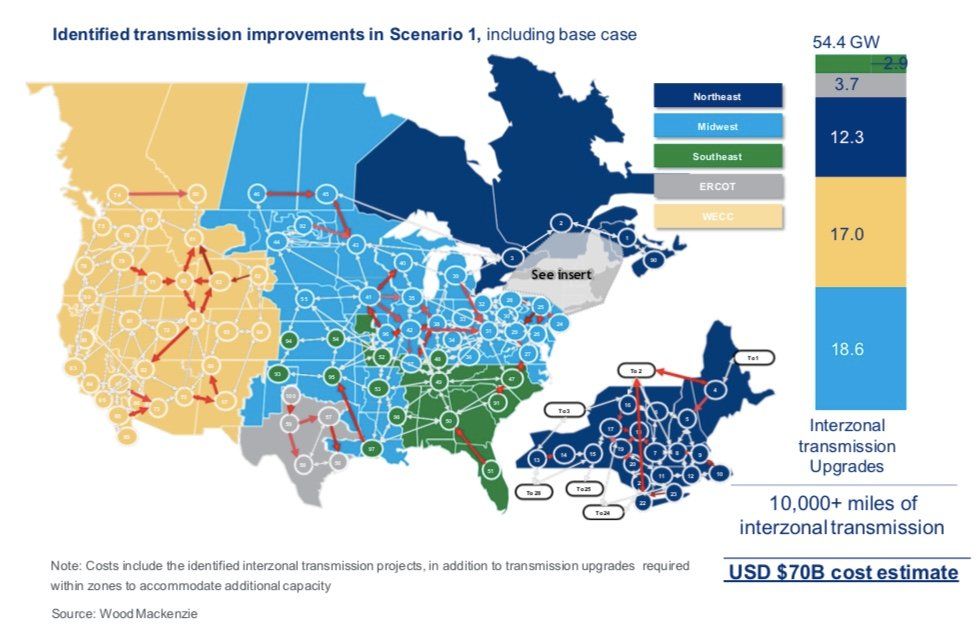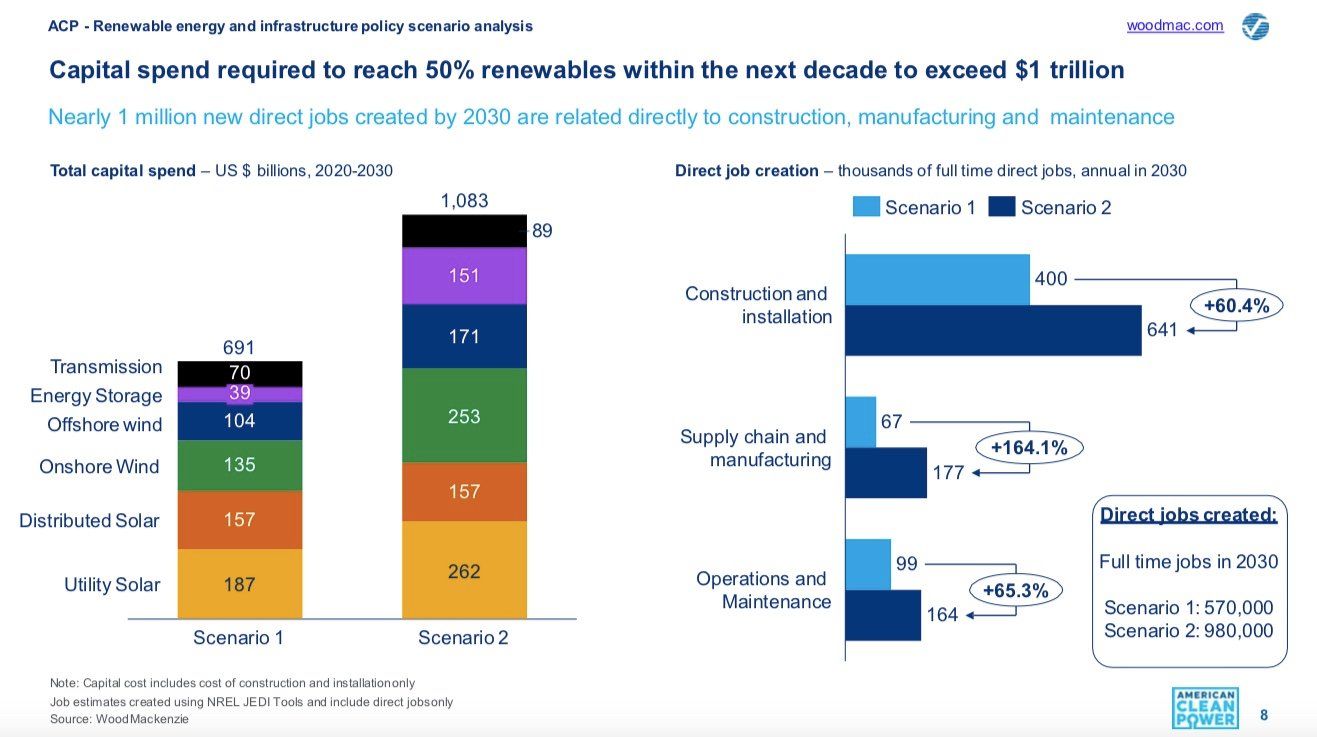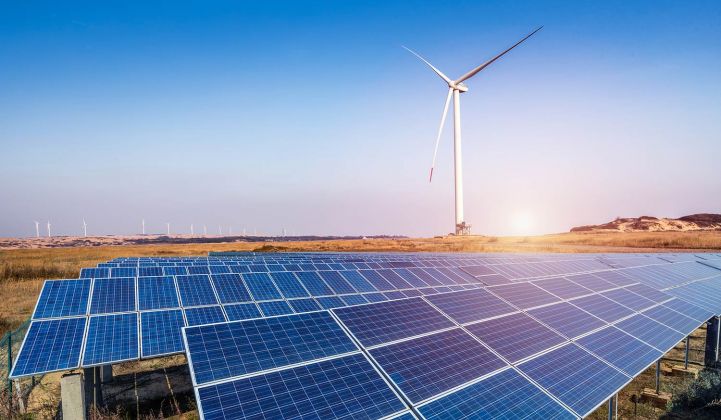The U.S. can get half of its electricity from renewables by 2030 — but it will take more than executive actions from the incoming Biden-Harris administration to get there.
So finds a new report from Wood Mackenzie analyzing the investments and policy changes needed for the U.S. grid to reach 50 percent renewables by 2030. That’s not quite as aggressive as President-elect Joe Biden’s goal of a zero-carbon U.S. energy sector by 2035, but it’s still a lofty target that will require a radical reconfiguration of the country’s generation and transmission system to achieve.
“Getting to 50 percent would require a pretty widespread change to the U.S. power grid, particularly if targeting a 10-year timeframe,” said Aaron Barr, the report’s author and principal consultant with WoodMac’s Energy Transition practice. “But it’s certainly within the realm of the possible. Many of the necessary technologies have reached technical and commercial maturity but require policy support to drive significant levels of deployment.”
The Biden-Harris administration will have many options to act without congressional support to drive this kind of rapid decarbonization. These in themselves won’t be enough to hit 50 percent renewables by 2030. But they will be necessary precursors to getting there since they include key steps to modernize market structures and transmission networks that will lay the groundwork for further expansion, he said.

Executive actions to get to 37 percent
Executive actions on their own could allow the country’s renewables to roughly double to about 37 percent of total generation capacity by 2030, the report finds. Some of these are already part of Biden’s climate and energy plans, such as committing federal agencies to procure clean energy and improve energy efficiency, or expanding and streamlining renewable development on federal lands and federally regulated ocean waters.
Others are part of a broader agenda from clean energy groups and states with carbon-reduction mandates. These include reforming federally regulated wholesale market policies that disincentivize state-subsidized clean energy and improving transmission-planning and cost-allocation processes.
Most of the $690 billion in investment needed to reach this 37 percent by 2030 goal is tied up in building out utility-scale and distributed solar PV and onshore and offshore wind farms, along with a smaller but still significant investment in energy storage capacity to retain grid reliability as intermittent renewables replace fossil fuel power plants.
But Barr said “the biggest driver is the increased and expanded transmission infrastructure,” even though the relative share of investment to get there is relatively small at about $70 billion. That’s because much of the limitation on renewable energy growth over the coming decade is tied up with transmission congestion, interconnection bottlenecks and lack of capacity to carry wind and solar power from far-off locales to load centers.
“The administration can do a lot to streamline permitting for many of these projects,” Barr said. Transmission proponents have proposed Federal Energy Regulatory Commission action to increase rates of return on new transmission and guide interregional transmission development, incentives for technologies to increase the efficiency of existing transmission, or even Department of Energy action to designate National Interest Electric Transmission Corridors to establish federal eminent domain authority for critical projects.

New policies to get to 50 percent
The report, sponsored by the American Clean Power Association, also modeled a U.S. grid under a hypothetical 50 percent renewable energy standard. The report doesn’t specify particular policies to achieve this target, but it does highlight the challenges in reaching it.
For one, shifting to such a high percentage of renewables compelled the researchers developing the model "to retire all the coal capacity nationwide,” Barr said, something that only some U.S. utilities have committed to. It also limits the addition of new natural-gas-fired power plants that still play a role in many utilities' long-term resource plans.
Absent the expanded use of new gas plants, the U.S. would have to “significantly ramp up investments in energy storage” to provide the reserve margins needed to maintain reliability on an increasingly intermittent renewable-powered grid, he said. The U.S. would need to grow from about 1.5 gigawatts of energy storage today to more than 188 gigawatts by 2030. That’s nearly four times as much as required under the 37 percent scenario, he noted.
The Biden administration has outlined policies that could support this kind of transition. They include a national clean energy standard to drive energy sector carbon emissions to zero by 2035, which would effectively push fossil fuels out of the picture.
Biden’s call for $2 trillion in investments over the next four years to support clean energy infrastructure across multiple industry sectors could also play a vital role in boosting private-sector investment needed to accomplish the transition.
The report shows more than $1 trillion in capital investment will be needed over 10 years for the onshore and offshore wind power, utility-scale and distributed solar PV, energy storage capacity and new transmission infrastructure to reach the 50 percent goal.
But those investments would also create nearly 1 million new jobs related to construction, manufacturing and operations of this new clean energy system, compared to about 570,000 jobs for the 37 percent scenario, the report finds.
“Renewable energy and related transmission construction activities can be a major source of domestic job growth and post-COVID economic recovery," Barr said.
Getting the policies to drive this growth will require congressional action, however, and it’s far from clear if Biden and Democratic allies will be able to pass laws to accomplish those goals. Much depends on the outcome of the January runoff elections for Georgia’s two U.S. Senate seats. That could yield a Republican majority or a 50-50 split between the parties, which could allow Democrats to overcome Republican opposition with incoming Vice President Kamala Harris able to break tie votes.

***
The 44-page report is available as a free download here.




